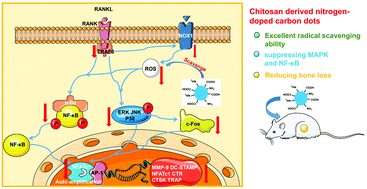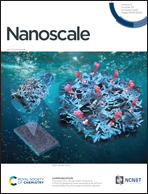Chitosan derived nitrogen-doped carbon dots suppress osteoclastic osteolysis via downregulating ROS †
Abstract
Osteoclasts are the main cells involved in normal bone remodeling and pathological bone destruction in vivo. Overactivation of osteoclasts can lead to osteolytic diseases, including breast cancer, bone tumors, arthritis, the aseptic loosening of orthopedic implants, and Paget's disease. Excessive reactive oxygen species are the main cause of osteoclast overactivation. We have synthesized chitosan derived nitrogen-doped carbon dots (N-CDs) with a high synthetic yield and the ability to scavenge reactive oxygen species (ROS). N-CDs effectively abrogated RANKL-induced elevation in ROS generation and therefore impaired the activation of NF-κB and MAPK pathways. Osteoclastogenesis and bone resorption was effectively attenuated in vitro. Furthermore, the in vivo administration of N-CDs in mice protected them against lipopolysaccharide (LPS)-induced calvarial bone destruction and breast cancer cell-induced tibial bone loss. Based on the good biocompatibility of N-CDs and the ability to efficiently remove ROS, a nanomaterial treatment scheme was provided for the first time for the clinical treatment of osteolytic diseases.



 Please wait while we load your content...
Please wait while we load your content...